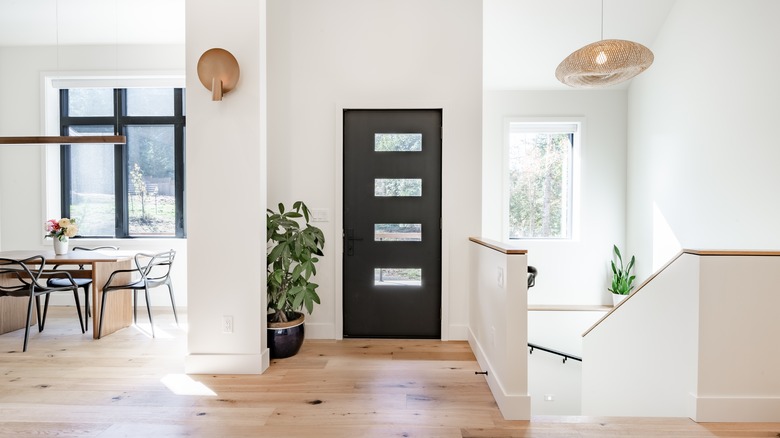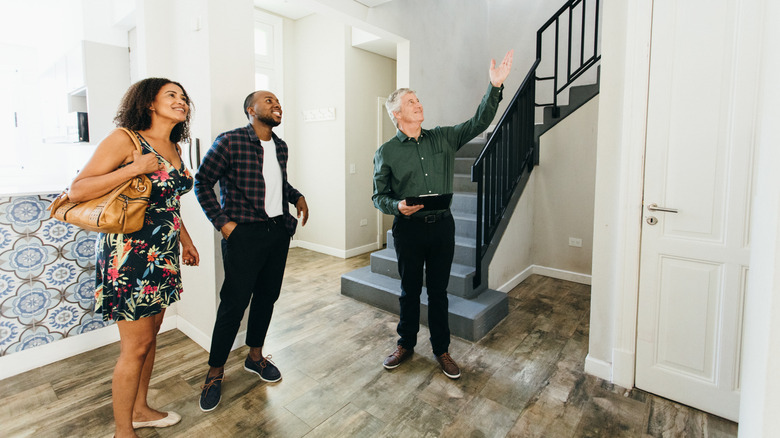The Troubling Effect Home Renovation Shows Are Having On New Homeowners
A main source of design inspiration for homeowners, HGTV has evolved into a one-stop-shop for home decor enthusiasts looking to spruce up their own abodes or get in on the shared satisfaction of watching a home transform from an outdated disaster to a modern dream for its owner. With such powerful influence in the real estate and interior design industries, the network has helped usher in a new era of aesthetics and trends that likely wouldn't have picked up as much steam without its platform and prominence.
But what happens when homeowners go overboard in bringing these popularized designs to life in their own houses? It creates a situation seen today where homes appear eerily similar in terms of layout and design. Home renovation shows are influencing new homeowners to surrender their personal creativity in their modernization efforts by conforming to mainstream contemporary design trends in the name of resale value and market popularity.
This circumstance has worked its way into the real estate scene as well, as long-running series such as "House Hunters" and "Love It or List It" have altered the way buyers go about searching for new properties. Buyers craving turnkey homes push owners to renovate their properties quicker, with some choosing to avoid changing their houses to their liking entirely. Here's more on why HGTV's programming inspires assimilation from a design perspective and what this could mean regarding how owners' relationships with their houses have changed over time.
A repetitive nightmare
HGTV offers a variety of renovation-themed shows to attract audiences, ranging from elaborate home makeovers in rural Texas to stake-heavy beach house rehab competitions on the coast. Each of these programs appears to follow a generic formula when undergoing major restoration, usually executing a project involving natural sunlight, open floor plans, funky light fixtures, and neutrals upon neutrals placed all throughout the home. When the network's expert interior designers implement the same trends into their televised work, droves of homes across the country begin to be modified to hop on the contemporary bandwagon as a result. This creates a situation where homes, both available and occupied, tend to appear almost indistinguishable on the inside, lacking much opportunity for external inspiration.
These modern trends carry over to newly-constructed homes as well. Contractors try to appeal to prospective homebuyers by incorporating trends commonly seen on social media and design shows into their new builds. Open floor plans and functional family living are concepts that home builders prioritize as buyers continue to look for ways to integrate their time spent cooking, eating, relaxing, and conversing inside the home.
Homebuyers have also developed an interest in indoor-outdoor living and easily-convertible living spaces, with builders attempting to satiate these interests through their latest designs. Some of the most popular home styles of today, including modern craftsman and farmhouse, are influenced by handiwork seen on television, as contractors take classic designs and transform them internally to fit modern-day homebuyers' needs.
Limited creativity among homeowners
Buying a house represents a milestone in a person's life. Unlike apartments, which generally restrict how much personalization renters can incorporate into their properties, a purchased home gives its owner the freedom to transform its interior and exterior in any way they see fit. But, with the rise in popularity of home improvement reality shows and projects on social media, cable television, and streaming services, homeowners now strive for a look that follows a mainstream aesthetic rather than crafting a home that exemplifies their personal likes and interests. Homeowners are granted less freedom to design their spaces in the style they want, which, according to a 2022 study published in the Journal of Consumer Research, transforms the home from a place that defines one's identity to one more consumerist-oriented.
Even real estate agents frown upon owners incorporating too much personality into their homes out of fear that the house's uniqueness will tank its property value, decreasing the likelihood that the home will sell quickly and at full price once the owner is ready to sell. In a reality where agents want buyers to be able to picture themselves inside the homes they tour, houses take the shape of blank canvases void of character or any design elements considered too niche for the average homeowner. In other words, homes staged to appeal to the masses are expected to sell quicker and at a selling price of up to 5% higher.


